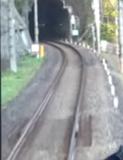
| Home | Open Account | Help | 242 users online |
|
Member Login
Discussion
Media SharingHostingLibrarySite Info |
International Railroad Discussion > Question: Japanese track detailDate: 02/19/20 11:04 Question: Japanese track detail Author: mile250 In a cab-view video of the Seibu railway, winding down through mountains, I saw that nearly every tangent between reverse curves has what appear to be built-in re-railers on both rails. This is the best screen capture I could get. Further info?
Glen Matteson San Luis Obispo, California  Date: 02/19/20 11:50 Re: Question: Japanese track detail Author: milwrdfan Not sure, but could these be ways to contain rail shrinkage and expansion due to temperature changes? In many places around the world rail anchors are used, but could this be a different way to deal with changing rail lengths due to temp changes?
Date: 02/19/20 17:06 Re: Question: Japanese track detail Author: portlander milwrdfan Wrote:
------------------------------------------------------- > Not sure, but could these be ways to contain rail > shrinkage and expansion due to temperature > changes? In many places around the world rail > anchors are used, but could this be a different > way to deal with changing rail lengths due to temp > changes? I agree that they look like expansion joints. Date: 02/19/20 17:29 Re: Question: Japanese track detail Author: choodude portlander Wrote:
> I agree that they look like expansion joints. Here is an example: http://www.cmi-promex.com/content/curved-rail-expansion-joints and more pictures: http://www.cmi-promex.com/category/image-galleries/curved-rail-expansion-joints Brian Date: 02/19/20 20:35 Re: Question: Japanese track detail Author: mile250 Thanks to all for responses. Expansion joints was my first thought, but I wasn't aware of the "bent rail" type, only the tapered kind, and mitre joints used on bascule bridges.
  Date: 02/20/20 10:49 Re: Question: Japanese track detail Author: 251F Thanks for posting.
Did you get a chance to ride the Chichibu Railway? I rode the Chichibu Railway last October but didn't have time to ride the Seibu Railway. Next time... I went to the west end of the line at Mitsumineguchi, Saitama. I rode the Paleo Express which was great fun. Although by the time we reached the end of the ride at Kumagaya, the poor engine crew (engineer, brakeman and fireman) were caked in soot from the coal fired 2-6-2 C58 class former JNR steam locomotive. The other objective of the trip was to photograph some of the Chichibu Railway's immaculate little Hitachi box cab electrics. But, as so often seems to be the case, the weather was less than welcoming. It started raining early in the morning and by the time the Paleo Express departed Mitsumine Station, it was a downpour. The only chance I had to photograph the Chichibu freight motors was a brief stop at Takekawa Station. In the driving rain, here is 105 (Hitachi, 1956) on the point of an empty hopper train heading back to be loaded with limestone for Chichibu's principal owner, Taiheiyo Cement. I did note several of the motors have been repainted into vibrant colors. Yellow, green and orange were spotted at various points on the Paleo Express trip. d.    |